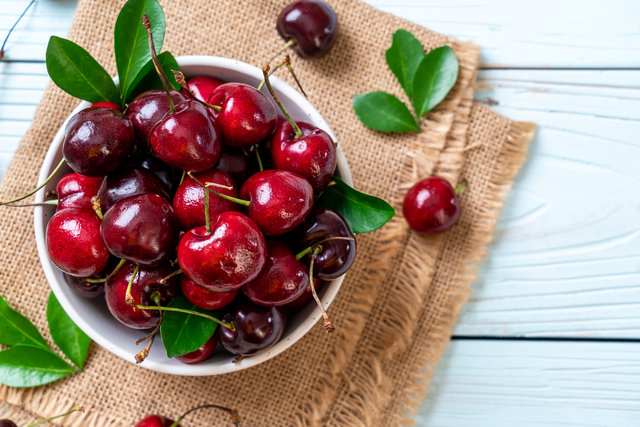Can Dogs Eat Cherries? The Comprehensive Guide
As a fellow dog lover and owner, and like most of us, I’ve often found myself questioning what my furry friend can and cannot eat from my own plate. While recently enjoying some fruits, I wondered: “Can dogs eat cherries?”
I personally love them, but can dogs eat cherries?
Let’s find out together.
Dogs and Fruits: A Brief Overview
Dogs are primarily carnivores, but they do enjoy a variety of fruits and veggies in their diet. Not only can these offer variety and flavor, but they also provide essential vitamins and minerals.
However, not all fruits are safe for dogs, and cherries fall into this ambiguous category.
What Are Cherries?
Cherries are small, round fruits that come in a variety of types, such as sweet cherries and sour cherries. They’re loved by many for their sweet and tangy flavor, and they’re packed with beneficial vitamins and minerals.
But does this goodness translate well for dogs?
Potential Risks of Cherries for Dogs
Feeding cherries to dogs is not straightforward and can even lead to potential health risks. Here’s why:
Risk #1: Cyanide in Pits, Stems, and Leaves:
One of the significant risks comes from the cyanide found in cherry pits, stems, and leaves. Cyanide is a poison, and if your dog accidentally chews on a pit, stem, or leaf, it could potentially lead to cyanide poisoning. While a single cherry pit might not cause cyanide poisoning in a large dog, smaller breeds are at a higher risk. Regardless, ingestion of these parts should be avoided.
Risk #2: Choking Hazard:
Cherry pits pose a significant choking hazard to dogs, especially smaller ones. Even if your dog doesn’t chew the pit and release the cyanide, the pit can still get lodged in their throat or intestinal tract.
Risk #3: Upset Stomach:
While the flesh of the cherry is safe for dogs to eat, it can still cause an upset stomach in some dogs, especially if they’re not used to eating fruit. It can lead to symptoms like diarrhea and vomiting.
Risk #4: Possible Allergic Reaction:
Although rare, some dogs might be allergic to cherries. An allergic reaction can cause symptoms such as itching, swelling, difficulty breathing, and other discomforts.
Given these risks, cherries might not be the best fruit to share with your furry friend. There are other safer fruits that your dog can enjoy without these concerns.
Potential Health Benefits of Cherries for Dogs
Now that we’ve covered the potential risks, I will cover some potential health benefits. That being said, when considering the potential health benefits of cherries for dogs, it’s critical to tread carefully due to the potential risks associated with this fruit, which we’ll cover later in this article.
However, there are a few benefits that dogs can get from cherries, mainly from the flesh of the fruit:
Antioxidant Power:
Cherries are rich in antioxidants, which can help to reduce inflammation and potentially ward off chronic diseases. The antioxidants found in cherries might help your dog’s overall wellbeing.
Vitamin C:
Vitamin C, which cherries have in abundance, helps to support a strong immune system. As mentioned earlier, dogs can produce their own Vitamin C, but in times of stress or illness, they might benefit from an additional supply.
Fiber Boost:
The fiber in cherries can support a dog’s digestive health, providing a sense of fullness and promoting regular bowel movements.
Hydration:
The high water content in cherries can contribute to your dog’s hydration.
It’s essential to remember, though, that while these benefits exist, they might not outweigh the risks associated with feeding cherries to dogs. There are many other safe fruits and vegetables that provide similar benefits without the risks that cherries pose. Always consult with your vet before adding new foods to your dog’s diet.
What Happens If a Dog Eats Cherries?
Even though we’ve established that cherries can pose certain risks for dogs, it’s essential to understand what actually happens if your dog does end up eating a few. Let’s break down the potential scenarios.
Ingesting One or Two Cherries Without Pits: Should Be Alright, Watch for Signs of Discomfort
If your dog has eaten one or two cherries, there’s likely no immediate danger, especially if your dog is larger. However, observe your pet for any signs of discomfort, such as coughing, gagging, or other signs of a possible choking hazard. Also, keep an eye out for signs of gastrointestinal upset, like diarrhea or vomiting.
Chewing on the Pits, Stems, or Leaves: Watch Very Carefully and Consider Vet Immediately
As previously stated, these parts of the cherry contain cyanide. If your dog has chewed on these parts, look out for signs of cyanide poisoning. These can include dilated pupils, difficulty breathing, and excessive panting. In severe cases, this can even lead to shock or death.
Eating Several Cherries: Watch Very Carefully, If Cherry Has Pits, Consider Vet Immediately
If your dog has eaten several cherries at once, especially without the pits being removed, this should be treated as a potential emergency. Cyanide poisoning becomes much more likely, especially for smaller dogs.
If your dog shows any signs of distress or discomfort after eating cherries, it’s important to contact your veterinarian immediately. Remember, while cherries themselves might not be deadly for dogs, the risks they pose are significant enough that it’s better to avoid them and stick to safer, dog-friendly fruits instead.
What to Do If Your Dog Eats Cherry Pits, Stems, or Leaves?
Should your dog ingest cherry pits, stems, or leaves, the reaction needs to be swift and immediate due to the cyanide content. Here’s what to do:
1) Assess the Situation:
Start by finding out how much your dog has consumed. Did your dog just nibble on a stem, or did they swallow a handful of cherries whole? The severity of the situation will vary greatly based on these factors.
2) Contact a Veterinarian Immediately:
If you suspect your dog has ingested the pits, stems, or leaves of cherries, get in touch with your vet right away. Don’t wait for symptoms to show up as cyanide acts rapidly. Make sure to provide all the necessary information such as your dog’s size, age, breed, and the estimated amount of cherries ingested.
3) Follow the Vet’s Instructions:
Your vet may instruct you to induce vomiting at home or rush the dog to the clinic immediately depending on the situation.
4) Prepare for Veterinary Treatment:
The vet may administer oxygen therapy, fluids, and other treatments to counteract the effects of cyanide poisoning.
5) Monitor Your Dog’s Health After the Incident:
Even after treatment, keep a close eye on your pet’s health. Watch for any lingering or late-appearing symptoms and communicate these with your vet.
Remember, time is of the essence if your dog consumes any part of a cherry that contains cyanide. Quick action can make all the difference. As always, prevention is the best medicine – it’s better to keep cherries and other potentially harmful foods out of your dog’s reach.
Alternative Fruits for Dogs
If you’re looking for safer fruit options for your dog, consider apples (without the seeds), bananas, blueberries, or watermelon (without seeds or rind). These fruits are safe for dogs to consume and offer their own range of health benefits.
Key Takeaways
While cherries can offer some health benefits to dogs, the potential risks can outweigh the benefits, and it can be better to feed a fruit or vegetable with far less health risks.
Always consult with your vet if you’re unsure about feeding any new foods to your dog.
Cautious Consumption: The flesh of cherries can be enjoyed by dogs, but only when served correctly – pitted and in small amounts. Too many cherries can lead to gastrointestinal upset due to their high fiber content.
Nutritional Value: Cherries are packed with beneficial nutrients such as vitamins A and C, fiber, and antioxidants, which can support a dog’s health when offered in moderation. That being said, there are far better options than cherries that offer health benefits with far less risk.
Avoid Toxic Parts: Cherry pits, stems, and leaves contain cyanide and can be extremely toxic to dogs. Even small quantities of these can lead to poisoning.
Responding to Ingestion: If your dog ingests cherry pits, stems, or leaves, contact a veterinarian immediately. Their guidance and potential treatment can be life-saving for your pet.
Safe Alternatives: If you wish to give your dog a cherry-like treat, consider cherry-flavored dog-approved snacks or foods. Always double-check the ingredients and consult your vet if unsure.
Prevention is Best: The safest way to protect your dog from potential cherry toxicity is to keep cherries out of their reach and only offer safe foods that are appropriate for canine consumption.
Can Dogs Eat Cherries Conclusion
Our dogs depend on us to keep them safe and healthy. Even though they might be eager to try whatever we’re eating, it’s our responsibility to make sure what they’re consuming won’t harm them. When it comes to cherries, it’s better to be safe and opt for dog-friendly fruits instead.
Can Dogs Eat Cherries FAQs
1. Can dogs eat cherries?
While dogs can technically eat cherries, they come with potential risks, mainly due to their pits, stems, and leaves which contain cyanide. Therefore, it’s usually safer to avoid them.
2. What should I do if my dog eats cherry pits?
Contact your vet immediately if your dog eats cherry pits. They pose a choking hazard and can cause cyanide poisoning.
3. Are there any fruits that are safe for dogs to eat?
Yes, fruits like apples (without seeds), bananas, blueberries, and watermelon (without seeds or rind)
Additional Dog Diet Info:
We cover additional vegetables and foods in detail:




